Building an Effective Project Team
During the executing phase the HR management plan describes how confirming the necessary human resource availability and obtaining the personnel needed to complete project assignments is achieved. It is complicated by the fact that individuals with different skills sets will be required at different points throughout the project and the HR plan outlines how this will be accomplished.
For example, a software project may be two-thirds completed before specialist testing personnel are needed. Consequently, acquiring members for a project team continues throughout the executing process group.
Team working has been an important organizational issue for many years. However, the concept has historically described work within permanent functional teams such as sales, production and design. The rapid growth of project-based work has given rise to the creation of multi-disciplinary teams capable of rapidly accomplishing tasks that span the traditional internal boundaries present in many organizations.
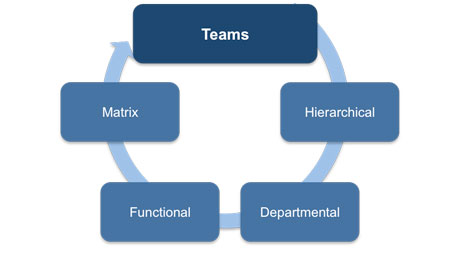 |
Successful team working requires careful consideration and design, such issues are address within the HR management plan and its related communications and stakeholder management plans. Generally, the more that an organization has tended towards a traditional hierarchical structure, the greater will be the challenge of implementing effective inter-departmental project teams.
Project teams can take on a variety of forms depending on the size of the project and the way in which it is staffed. Project environments range from dedicated and full-time project teams, through to instances where projects have little or no full time resource and operate by using only the resources from existing functional departments.
Organizations that are project orientated tend to maintain a full-time dedicated project resource, which is generically termed a project office. Project office staff will tend to specialize in areas such as: planning, testing, auditing and the monitoring of time, cost and performance against the plans. These staff will usually report to a single boss, who may be either a project manager or a project office manager.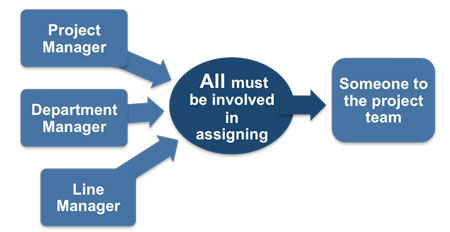 |
Departmental staff will be recruited on the basis of the skills and expertise that they can bring to the project. However, the appropriate technical or business skills need to be complemented by an ability and willingness to function effectively in the project environment. These individual's will report to the project manager, but they remain under the overall control of their own departmental, or line manager - they are therefore working in what is called a matrix management environment.
The appointment of departmental staff to projects should be a decision made jointly by the relevant project and departmental, or line, managers. The involvement of line managers in these appointments is important as they have the necessary experience to highlight critical areas of the project from a technical viewpoint. Furthermore, by involving line managers in the early stages of project planning they are more likely to develop a positive attitude to the project.
Disagreements may result in the negotiations between the project and the line manager on both the level of staffing required by the project and possibly over the individuals to be assigned. However, only in situations where an impasse has been reached should senior management be asked to arbitrate.
The human resource plan provides guidance on how project human resources should be identified, staffed, managed, controlled, and eventually released. It outlines the roles and responsibilities of each team member clarifying their authority and relevant competency.
Project organization charts are used to show the reporting relationships often using as a responsibility assignment matrix (RAM) or an equivalent method.
The plan also outlines the planned staff acquisition, release plan and resource calendars to show how they will be used on the project. It highlights how any training needs, recognition, rewards, compliance and safety will be met during the life of the project.
If resources are needed that are not available within the organization then they may also need to deal with outside agencies or other suppliers. Many organizations will have a list of preferred suppliers and may also have previously agreed terms and conditions for dealing with them. The procurement plan should be referenced to ensure that all external resources are obtained in accordance with organizational policy.
The virtual team format makes it possible to form teams of people from the same company who live in widespread geographic areas, use employees who work from home, and include people with mobility limitations or disabilities. It can also cut down on the expense of having the whole team in one place and in travel expenses.
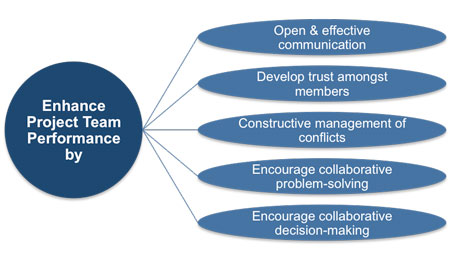 |
How project team performance will be managed is described in the plan and states how they aim to develop such productivity by using open and effective communication, developing trust among team members, managing conflicts in a constructive manner, and encouraging collaborative problem-solving and decision-making.
Team building is such an important and complex topic that an aspiring project manager should take the time to study as much as possible on this subject. There are four free eBooks available from this website that deal with team leadership and team building and you may find them useful in developing your team leadership skills and competencies.
For the purpose of project management there are some general points you should take into account when executing this process. These are:
1) Addressing team member's concerns about joining the project
2) Encouraging ownership of project tasks
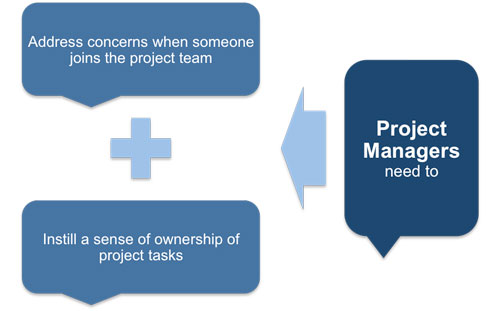 |
Try to arrange a one-to-one discussion with each team member in order to welcome him or her to the team and establish personal contact. A short and informal discussion represents an opportunity to motivate people from the very beginning of their involvement with the project. This opportunity should not be wasted because a positive attitude to the project will deliver numerous benefits in terms of enthusiasm and performance. Remember, projects have the potential to be seen as dynamic working environments, providing an opportunity to work with personnel from other areas of the organization and enabling staff to gain new skills and enhance their career prospects.
This discussion is also important because it can help reduce anxiety and stress by addressing any concerns that new team members may have. Anxiety among members of a new project team is almost inevitable. Personnel will be working with unfamiliar faces often in an environment that is still taking shape.
This anxiety is typically focused on five key issues.
1) Lack of familiarity with other members of team
If the project manager, or their assistants are unfamiliar to the team members then the team members will naturally be concerned about the manager's leadership style and how it will affect their everyday work.
2) Correlation of project needs to their skills and interests
They may be concerned about the nature of the project and whether or not it will match their own level of expertise and professional interests.
3) Technical viability and likelihood of success
Furthermore they might have private worries about the technical viability of the project and how its failure may reflect on them.
4) Probability of relocation
If involvement with the project involves relocation, either within a building or more remotely, then management should bear in mind that this often causes heightened anxiety and stress amongst project team members.
5) Fair allocation of work
The fair distribution of the workload may be an area of concern, as may the perceived level of proficiency and dedication of some of their new colleagues.
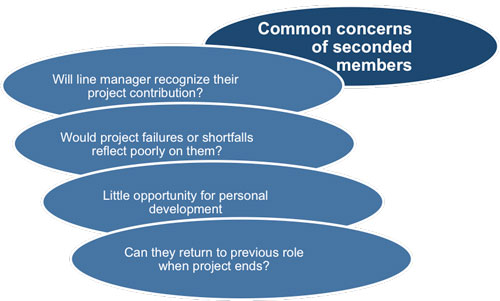 |
The following concerns are often felt by staff seconded to projects from other departments who may feel increasingly isolated and left behind in relation to their long time colleagues and the departmental practices with which they are familiar. They may be concerned:
1) About the extent to which the efforts they expend on project related work would be recognized and may feel that undertaking project related work might jeopardize their career prospects. They may believe that however hard they work on the project it will not affect their chances of advancement within their own department.
2) That the project itself may not be an outstanding success and that any perceived failure on its part will reflect badly on them as individuals.
3) About what happens to them at the end of the project. Perhaps their department will learn to cope without them develop new procedures whilst they are away.
4) Projects are not seen as training oriented environments in which to develop personal skills.
One of the great challenges of project management is to bring together an effective team and bring it up to speed quickly. This is one of the key aims of any HR project management plan. Anxiety among team members is natural and this needs to be addressed as early as possible so that project staff can focus on the needs of the project rather than on their own anxieties.
One way to do this is to encourage their ownership of project tasks. This can be achieved by involving all team members in the planning and scheduling of the activities that they will work on. In smaller teams it may be realistic to involve all members in the planning process whilst in larger teams it may be necessary to restrict the involvement to team or section leaders.
You may also be interested in:
Managing a Project Team | Developing the Project HR Plan | Building an Effective Project Team | Developing the Project Team | Dealing with Conflict in the Project Team | Planning Project Communications | Optimizing Project Communications | Managing Project Communications | Identifying Project Stakeholders | Keeping Project Stakeholders Informed.
|
|


